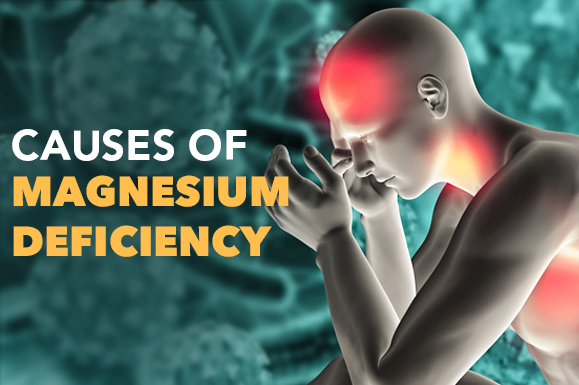Magnesium is often cited as the element most deficient in modem diets.
Total-body magnesium is about 25 grams, of which more than 50% resides in bone, 35% in skeletal muscle and 1 to 2% in blood. 20% of blood magnesium is protein bound. The bone pool is not completely bioavailable when general depletion occurs.
According to the Third National Health and Nutrition Examination Survey, the mean magnesium intake for males and females is 323 and 228 mg/d, respectively, far less than the dietary reference intakes of 420 and 320 mg/d, respectively. Daily intakes of magnesium range between 84 and 598 mg.
Similar to calcium, bone magnesium decreases with age. Soft tissue magnesium concentration varies between tissue types, and cellular transport is regulated by numerous factors, including insulin, growth factors and catecholamines.
Sex hormones have also been demonstrated to impact total serum and ionized magnesium in women, depending on the time in menstrual.
Contents
- Physiological Function of Mineral Nutrient Magnesium
- Causes of Deficiency of Mineral Nutrient Magnesium
- Health concerns due to Magnesium deficiency
- Assessment of Magnesium Mineral Status
- Supplementation of Magnesium
- Best or most Bio-Available or Active form of Magnesium
- Food sources for Magnesium
- Conclusion
Physiological Function of Mineral Nutrient Magnesium
Magnesium plays a key role in more than 350 enzymes, primarily as Mg-ATP complex in energy-dependent activities.
Magnesium is involved (as Mg-ATP) in virtually every metabolic process occurring in the body, including active transport such as the sodium-potassium ATPase pump, and cell signaling, including cAMP in protein phosphorylation.
This mineral is involved in multiple steps of RNA and DNA synthesis. It also plays structural roles in DNA, cell membranes and chromosomes.
Magnesium plays numerous key roles in enzymes involved in protein, carbohydrate and fatty acid metabolism. Examples include the amino acid transaminases, pyruvate dehydrogenase, and delta-6 desaturase enzymes.
Magnesium is a key cofactor in both methylation and sulfur amino acid metabolism, and is thus involved in the production of glutathione and S-adenosylmethionine. Magnesium is also required for formation of active cofactors from vitamins B1, B2, B3, B6 and pantothenic acid.
Causes of Deficiency of Mineral Nutrient Magnesium

Magnesium plays a key role in health and hence it should be regulalry consumed in the right amount. However, a number of factors may interfere with that. To begin with, low intake of magnesium is usually caused by an inappropriate diet. Most individuals depend on processed foods. Foods that do not contain mg-rich foods, such as vegetables and grains (leafy greens, nuts, seeds, and whole grains), are consumed by them. Due to this fact, diets are below the daily magnesium requirement.
In addition, poor intestinal absorption contributes significantly. Impairments in absorption are associated with, but not limited to, celiac disease, inflammatory bowel disease, Crohn’s disease, chronic diarrhea and gastric bypass surgery.
Second, magnesium is lost in excess quantities either through the kidneys or through the gastrointestinal tract.. Diabetics with type 2 might urinate a lot.
Moreover, long-term alcohol intake may decrease the intake and surmount the excretion.
Moreover, some drugs, such as diuretics, proton pump inhibitors, some antibiotics, and chemotherapy medications, may disrupt the magnesium balance.
There can also be an older age. As we grow old, the gut takes less and the body produces more. Moreover, elderly people do not consume enough mg-rich foods.
Lastly, magnesium can be rapidly lost due to physical stressors (burns, excessive sweating, etc.). Hormonal imbalances like hyperaldosteronism may also contribute to an increase in renal loss.
Consequently, an unhealthy diet, absorption issues, excessive leakage, medications, aging, and stress might be the cause of the malfunction of low magnesium. The prerequisite of the restoration of the balance is finding the cause.
Modern diets often lack whole foods that protect against deficiencies—learn how to incorporate superfoods like quinoa in our Quinoa Nutrition Facts, Benefits & Recipes article.
Health concerns due to Magnesium deficiency
Muscle weaknesses
Muscular twitching and weakness are the early symptoms of magnesium deficiency. Muscles cannot relax fully. Thus, twitches continue. Next, arrhythmias may occur. The heart’s rhythm falters. Consequently, you may experience palpitations or pain in the chest. Then irritability develops. Nervous systems do not relax. It results in mood swings or anxiety.
In addition, exhaustion and muscle spasms increase. Magnesium is an ATP-producer and a muscle magnesium. So, it’s loss produces fatigue and spasms. Therefore, you need magnesium for muscles.
Convulsions
In addition, convulsions can follow. Low magnesium affects the stability of the brain. Seizures may result. Also, poor growth is related not only to children. Magnesium aids in energy metabolism and cell division. In its absence, individuals may experience a slow development. Then, insomnia emerges. There is a break in the work of neurotransmitters. Thus, sleep quality drops. You can have trouble falling or maintaining sleep.
Depression and anxiety
Also, depression may deepen. Magnesium equalizes mood-regulating mechanisms. In its absence, there is a loss of emotional strength. Moreover, hypertension appears most of the time. Magnesium dilates blood vessels. A lack of it tightens them. That raises blood pressure. Lastly, cardiovascular disease is predicted. The long-lasting lack damages the heart and vessels.
Also, anxiety and mental fog may get worse. Magnesium also takes part in the management of neurotransmitters that affect mood and attention.
Other Symptoms
More than the initial list, there are other health issues that emerge. Let me give you an example of how migraine headaches may be aggravated by low magnesium on blood vessel tone and neurotransmitters. On the same note, there is an increased risk of osteoporosis. Magnesium is essential to bone density and mineral balance.
Thus, magnesium deficiency may have physical and mental effects. There is an urgent need to address it with the help of mg-rich foods, balanced diet, and adequate consumption. Eating a diet with potassium magnesium rich foods is important.
Assessment of Magnesium Mineral Status
Direct markers
Serum Magnesium Concentration
To begin with, serum magnesium concentration is the most widespread direct marker. Clinicians rely on it most. Nevertheless, it is a non-representative of total body magnesium (less than 1 percent). Hence, it gives a restricted perception of magnesium action. In many cases, the level of magnesium in the blood can be normal, yet tissues may be deficient in magnesium.
In addition, it has ionized magnesium. It is the form that is physiologically active. It is rarely measured by clinical labs. The reason is the need to use special tools and electrode methods. These are not common.
Magnesium Concentration in RBC
Next, the magnesium concentration of the red blood cell (RBC) gives further insight. It is a reflection of the intracellular stores. It is a reaction to changes in diet or supplement food. Therefore, RBC magnesium is more precise than serum. It is not commonly used in standard testing, however, and is more common in research.
Magnesium Load Test
The other direct method is the magnesium load test. A given amount of magnesium is administered in this test. Urinary magnesium excretion is then followed. Deficiency is indicated by retained magnesium. This can be regarded as a gold standard. Yet, it is invasive. It involves 24-hour hospitalization and supervision. Hence, it is more of a research tool.
Advanced markers
Lastly are the advanced ones. They are muscle, magnesium, and even bone magnesium measurements. These reflect bodily stores. However, they are aggressive and need biopsies. They are mostly impractical in clinical practice.
To conclude, direct markers, serum, ionized, RBC magnesium, and the load test give narrow information. Nevertheless, both of them are limited. Some lack sensitivity. The rest are too complicated or obtrusive to use.
Functional Biomarkers
In contrast to direct tests, functional markers test the performance of the body in the case of low magnesium. Their effect is on magnesium function and not concentration.
Urinary Magnesium Excretion
To begin with, urinary magnesium excretion is a functional marker. A 24-hour urine sample demonstrates the quantity of magnesium being kept or excreted by the body. Poor retention may be indicated by high excretion. Low excretion, particularly following the magnesium load test may indicate a deficiency. However, the outcomes may differ with the state of hydration and kidney well-being.
Dietary Assessment
Then, dietary assessment is an indirect functional tool. The consumption of food rich in magnesium is monitored and is the difference between whether an individual is obtaining adequate magnesium in a day or not. It can be better understood when combined with symptoms to provide a more precise picture of the status. Nevertheless, the absorption is not always the same, and food surveys can be deceptive.
Psychological Responses
In addition, physiological responses are indicators. The neuromuscular hyperexcitability, abnormal heart rhythms, or the inability to develop exercise recovery are cues to low magnesium in muscles. Supplementation in such situations tends to enhance functioning.
Other important markers
The other useful marker is the magnesium depletion score or clinical questionnaires. These are the tools that correlate symptoms such as cramps, insomnia, and fatigue with the potential magnesium deficiency. They do not directly measure the level of blood, but they lead the doctors to the testing or dieting recommendation.
Lastly, functional markers, urinary loss, diet records, symptom scores, and clinical responses are combined to give a more dependable image. These measurements reflect the actual outcomes of magnesium deficiency, which may remain undetectable by blood tests in some cases.
Functional markers are therefore useful in the clinical and research contexts. They determine the effectiveness of magnesium use in the body and guide interventions, including changing the diet or using magnesium supplements.
Comparison of Direct vs. Functional Markers of Magnesium
| Aspect | Direct Markers | Functional Markers |
| What it measures | Actual magnesium levels in blood, urine, or cells | Magnesium activity and its effect on body functions |
| Common tests | Serum magnesium, RBC magnesium, urinary magnesium | Magnesium retention test, enzyme activity, and symptoms |
| Accuracy | May miss hidden deficiencies | Reflects the true physiological impact of deficiency |
| Usefulness | Good for baseline screening | Better for diagnosing functional deficiency |
| Limitations | Does not show intracellular activity | More complex, sometimes costly |
Supplementation of Magnesium
Food is the most effective source of magnesium taken up by the body. However, not every time does a diet suffice. A magnesium supplement will help in such cases. People who take supplements to satisfy the daily requirement of magnesium do so due to the inadequacy of food in providing magnesium.
The first thing is to select the appropriate form. The body absorbs magnesium citrate, magnesium glycinate, and magnesium chloride well. They are more efficient than magnesium oxide in supporting magnesium functions. Oxide is not as readily absorbed and may cause stomach problems. Therefore, it is typically suggested that citrate or glycinate should be used to increase absorbency and smoothness by experts.
Second, dosage matters. Adults require supplements of between 350 and 750 mg per day. For children, it is advised to intake between 200 and 600 mg/day.. Exceeding this can result in diarrhea and other digestive problems.
Also, there are certain forms that have their own purposes. To illustrate, magnesium glycinate may assist with relaxing the muscles and sleep. Magnesium citrate may also help in digestion and constipation in the meantime.
Finally, it is advised to see a medical practitioner. Some drugs or ailments can react with supplements. A physician may assist in balancing food sources, mg supplement options, and safe dosing to your requirements.
To clearly identify the amount, here are the recommended magnesium intake levels –
- Children 2-12 years: 200-600mg
- Adult male: 350-750mg
- Adult female: 300-700mg
Best or most Bio-Available or Active form of Magnesium
It is tricky to decide which type of magnesium would be the best. Many options exist. Nevertheless, some of them are better bioavailable and have certain advantages. The following are the most effective and most recommended types.
Magnesium Glycinate (Bisglycinate)
It is usually regarded as the gold standard of general use. This magnesium is bound to the amino acid glycine in this form. Magnesium Glycinate is non-irritating to the stomach and very absorptive. It is not very likely to be upsetting to the digestive tract, such as diarrhea. It facilitates sleep, decreases stress, and helps to relax the muscles. Magnesium Citrate is suggested by many practitioners for these reasons.
Magnesium Citrate
It is the other highly bioavailable form. It is citric acid-bound magnesium. Magnesium Citrate is easily absorbable and extensively available. It has a mild laxative effect and many use it as general supplementation and constipation relief.
Magnesium L-Threonate (Magtein)
This form is unique. It penetrates the blood-brain barrier. Initial studies indicate that it could stimulate mental acuity, memory, and cognitive ability. It promotes the health of the brain directly in comparison to other forms.
Other Specialized Forms
Magnesium Malate: This is a combination with malic acid that enhances energy production, helps relieve muscle pain, or support fatigue, and thus is utilized as an athletic or fibromyalgia support.
Magnesium Taurate: The form is a mix of magnesium and taurine. It may have usefulness in cardiovascular wellness and blood pressure control.
Why Bioavailability Matters
Nevertheless, their absorption is poor, and approximately 4 percent gain entry into the bloodstream, and typically lead to digestive discomfort, thus not as efficient.
Food sources for Magnesium
The most natural and effective way of fulfilling your body’s needs is to get enough magnesium in your daily diet. There is a wide variety of magnesium-rich foods, and including them in your regular diet can prevent deficiency.

Some of the most significant magnesium sources are given below:
Nuts and Seeds
The richest natural sources are of magnesium nuts and seeds. Excellent are almonds, cashews, peanuts, sunflower seeds, chia seeds and pumpkin seeds. Intaking a small amount of nuts and seeds can fulfill your daily magnesium requirements.
Whole Grains and Legumes
Whole grains of brown rice, quinoa, oats and whole wheat bread are good sources. Not only do they supply magnesium they also supply fiber and B vitamins. Legumes like black beans, chickpeas, and lentils also contain the magnesium sources of plant food in a strong form.
Leafy Green Vegetables
Magnesium is a vitamin present in large quantities in the green dark vegetables especially spinach, kale, and Swiss chard. They contain high chlorophyll levels thus can be termed as powerful potassium-magnesium-rich food to keep the heart and the muscles healthy.
Fruits and Other Foods
Fruits also are rich in magnesium. Banas, avocados, dried fruits, and figs contain fast and healthy foods in substantial quantities, as do dark chocolate and fatty fish e.g. mackerel and salmon.
All in all, the magic formula to regular magnesium consumption is a mixture of nuts, seeds, grains, greens, and fruits. These foods that contain magnesium not only meet the daily magnesium requirement but also give an all-around well-being in a more natural manner.
Here is a simplified food chart for you to understand food choices for your daily magnesium intake:
| Food Item | Serving Size | Magnesium Content (mg) | Notes |
|---|---|---|---|
| Almonds | 28 g | 80 | High in healthy fats and protein |
| Pumpkin Seeds | 28 g | 150 | Excellent for snacking |
| Spinach (cooked) | 1 cup | 157 | Rich in chlorophyll, it supports muscles |
| Black Beans (cooked) | 1 cup | 120 | Good plant-based protein source |
| Quinoa (cooked) | 1 cup | 118 | Gluten-free, high fiber |
| Banana | 1 medium | 32 | Quick energy, also potassium-rich |
| Chia Seeds | 28 g | 95 | Can be added to smoothies or yogurt |
Conclusion
Magnesium is not just a mineral. It is involved in over 300 processes in the body. It is a vital part in promoting the well-being of the muscles and body organs such as the heart, good sleep and low levels of stress. Nevertheless, not everybody gets sufficient. Magnesium deficiency can be attributed to bad diet, medical or lifestyle conditions.
The good thing is that you can do it naturally. Eating nuts, seeds, greens, legumes, and whole grains will make you maintain your levels within check. Supplementation is safe when the diet is inadequate like magnesium glycinate form, or magnesium citrate. The most optimal sources and forms should be known so as to maximize the effects of magnesium.
Regular consumption helps in energy, mood, and well-being. Eat magnesium each day. The smallest of differences can go a long way. Your health will be pleased that you have.Learn more about daily nutrition habits and top food sources on Vitsupp.
Magnesium is a vital mineral nutrient. It prefers in excess of 300 biochemical responses. It helps in muscle functioning, conduction of nerves and heart fitness. Magnesium is also involved in making bones stronger, generating energy and reducing stress. It cannot be made by your body, and it must be acquired in the form of magnesium rich foods or supplements. Getting the proper amount of magnesium per day ensures that your body is at its size. Its absence can cause fatigue, cramps or irregular heartbeats. Magnesium is a substance that binds with calcium, potassium, and vitamin D in order to take care of general health conditions and hence it is, truly, an all-rounder when it comes to the daily health.
Magnesium is found in abundance in most fruits. Bananas, avocados, figs, blackberries and raspberries contain good amounts. Dried fruits like dates, prunes and raisins are also good. These are natural magnesium-containing fruits that may help to meet your daily magnesium need. Eating them facilitates magnesium functioning, including muscle relaxation and nerve impulses. They may be put into smoothies, to oatmeal, or snacks. Fruits are also a source of fiber, antioxidants and vitamins besides magnesium which has a twofold health advantage. In order to have a convenient natural source, focus on colorful and nutritious fruits on a daily basis.
The highest sources of magnesium are nuts, seeds and leafy greens. Pumpkin seeds, almonds, cashews, spinach and Swiss chard take the first positions in the list. Black beans, chickpeas and Lentils are also rich legumes. Dark chocolate and whole grains provide the extra magnesium. These foods will ensure that you will achieve your daily dosage of magnesium. Magnesium assists in muscle activity and repair in athletes. These foods add energy, heart benefits, and wellness to your diet. Plant and the whole food sources are easy to get maximum absorption, and magnesium is good in its natural form.
During pregnancy, the levels of magnesium you require are elevated. The majority of the guidelines suggest 350360 mg/day in pregnant women. This aids in the bone development of the fetus, muscle performance, and nerve development. You may satisfy this need with mg-rich fuels such as nuts, seeds, legumes, and greens. In some cases, a mg supplement can be recommended when there is an inadequacy in diet. Never use supplements without consulting a medical practitioner. The periconceptual magnesium daily intake lowers fatigue, cramps, and complications. It is also beneficial for the general health of the mothers and babies.
Yes, magnesium has the capacity to induce relaxation and sleep. It assists in relaxing the nervous system and muscles. The use of magnesium glycinate is particularly credited with promoting sleep. It can help you sleep better at night without feeling sleepy after taking it in the evening. It does so with the process of controlling neurotransmitters that instruct the body to relax. Although it does not relax as a medication, it effectively supports the sleep cycle of your body. To get to sleep or improve nightly rest, making sure that your diet has mg-rich foods or the appropriate mg supplement can help you relax and rest.
The most preferred types are well bioavailable and have minimal stomach irritation. Magnesium glycinate is best suited to relaxation and muscle health. Magnesium citrate helps digestion and relieves constipation. The magnesium L-threonate bypasses the blood-brain barrier, which boosts the memory and clarity of mind. In the case of energy and fatigue, magnesium malate is effective. Select a form based on your health objectives. Do not routinely take magnesium oxide as a supplement, as it does not get along well and can make your stomach upset. Combining supplements with mg-rich foods will make sure that you get your daily magnesium requirement effectively.
Magnesium may interact with calcium and zinc absorption when the two are regarded as one. Vitamin D generally is okay, since it acts with magnesium to maintain bones. Do not combine high doses of calcium supplements with magnesium; you must allow a gap between these two. This will make magnesium function optimally and avoid absorption competition. The safer method is eating mg-rich foods in addition to balanced vitamins. The avoidance is not as important as timing. Taking supplements in bits over the day aids in the absorption of all nutrients in your body and maximizes magnesium.
Yes, magnesium also controls blood pressure. It dilates blood vessels and helps the normal circulation. A proper magnesium supplement might lower the occurrence of hypertension and cardiac disease. Magnesium is found in high quantities in foods such as leafy greens, nuts, and seeds; such foods are able to support healthy blood pressure. The supplements of Mg could assist in cases of an inadequate diet. It is used with potassium- and magnesium-rich foods to maximize the health of the heart. A regular intake helps in magnesium activity as well as cardiovascular activity. This renders magnesium an easy but effective mineral in keeping the blood pressure healthy.
Yes, magnesium is not harmful to children in case of adequate dosage. Children require lower dosages than adults- the average is 80-240 mg daily, according to age. Mg-rich foods such as nuts and seeds, leafy greens, beans, and whole grains can provide magnesium to them. Supplements are typically necessary when there is a low intake in the diet. Mineral forms such as magnesium glycinate are cheap and non-aggressive. Magnesium aids muscle activities, energy generation, and the growth of bones in children. Parents can make sure that children receive safe, effective magnesium benefits without side effects through monitoring intake and with the consultation of a pediatrician.


